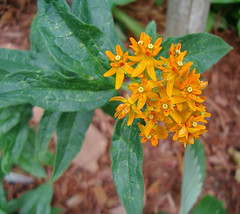I noticed that my hybrid Butterfly Milkweed – Asclepias tuberosa – had started to form buds. I had noticed the developing buds about a week and a half ago as I took a walk in my garden checking on all the plants as I went.
Luckily I had my camera at hand and I was able to take a few nice photos of the developing buds:
Butterfly weed is a herbaceous perennial that grows up to two feet in height. It dies back each winter and then re-sprouts in late spring from underground tubers.
Milkweed is slow to come up each spring. If you grow any form of milkweed you should always take care to mark the spot that it grows in each fall or at the very least try to remember where it was as it’s slow to make an appearance and you wouldn’t want to dig in the area and damage the plants roots.
Flower clusters of brilliant orange or red appear in midsummer. Once the blooms are spent attractive green pods develop. When the pods mature they open to release silky parachutes that drift away on autumn winds. This is how the butterfly weed propagates as the seeds of the butterfly weed are on these silky floating strands.
Each cluster has many flowers, several of these flowers will have an inner whorl of petals that are called the corolla and an outer whorl of sepals that is called the calyx. Butterfly Milkweed is a little different from other species of milkweed in that the sap is not milky nor are the leaves opposite.
Butterfly weed is a naturally occurring plant that grows east of the Rockies in North America. It’s preference is for well drained sandy soils.
If you’d like to grow these lovely flowers plant them in full sun to very light shade. Butterfly weed is hardy to USDA zones 4 – 10.
If you’d like to encourage butterflies to visit your garden this flower is a must as the caterpillars of Monarch butterflies feed only on milkweed foliage. Adult butterflies of many species enjoy sipping the nectar from the butterfly weeds blossoms.
I grow a few types of milkweed in my garden and every time I gaze out my kitchen window I see butterflies visiting many of my plants.

 Height: 2-3 feet (60 to 90 cm)
Height: 2-3 feet (60 to 90 cm)